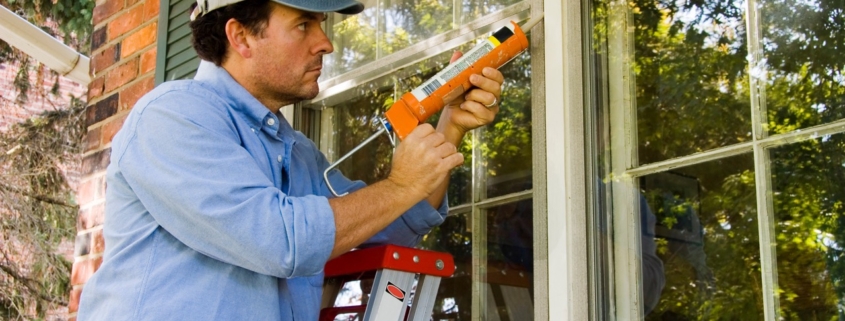How Often Do Windows Need To Be Caulked From the Outside?
Windows are essential to any home, providing natural light, ventilation, and a view of the surroundings. However, the caulking around windows can deteriorate over time due to weather exposure and wear and tear. This can lead to drafts, energy loss, and potentially costly damage. To maintain the integrity of your windows, it is crucial to understand the importance of caulking and the factors determining how often it should be done. This article covers a few questions and tips for maintaining window caulk.
Understanding the Importance of Caulking Windows
Caulk plays a vital role in window maintenance by creating a seal between the window frame and the surrounding structure. This seal prevents water, drafts, and pests from entering the home, ensuring energy efficiency and protecting against potential damage. Without proper caulking, windows can become vulnerable to leaks, rotting, and structural problems.
When it comes to window maintenance, caulking is often underestimated. However, it is a crucial step in ensuring the longevity and performance of your windows. By sealing the gaps and cracks between the window frame and the surrounding wall, siding, or trim, caulk acts as a barrier against the elements.
One of the primary benefits of caulking is its ability to prevent moisture from penetrating the home. Water damage can be a significant issue, leading to mold growth, wood rot, and even compromised structural integrity. By creating a watertight seal, caulking minimizes the risk of these problems, keeping your home safe and dry.
In addition to moisture, caulking also helps to prevent drafts. Gaps and cracks around windows can allow air to infiltrate, leading to temperature imbalances and increased energy costs. By sealing these openings, caulking improves energy efficiency and reduces heating and cooling expenses.
The Role of Caulk in Window Maintenance
Caulk acts as a barrier, sealing the gaps and cracks between the window frame and the surrounding wall, siding, or trim. It helps to prevent moisture from penetrating the home, which can cause water damage, mold growth, and even compromised structural integrity. By creating a watertight seal, caulking also minimizes the risk of drafts, which can reduce energy efficiency and increase heating and cooling costs.
Furthermore, caulking provides an added layer of protection against pests. Insects and rodents can find their way into your home through small openings around windows. Sealing these gaps with caulk creates a barrier that deters pests from entering, keeping your home free from unwanted visitors.
Another important aspect of caulking is its ability to enhance the aesthetic appeal of your windows. Over time, the original caulking may deteriorate, becoming discolored or cracked. By re-caulking, you can restore the clean and polished look of your windows, improving the overall appearance of your home.
Why Regular Caulking is Essential
Caulking is not a one-time task, but rather a regular maintenance practice to ensure the ongoing protection of your windows. Over time, caulking can deteriorate due to exposure to sunlight, extreme temperatures, and the expansion and contraction of building materials. As a result, re-caulking is necessary to maintain the effectiveness of the seal and prevent potential problems.
Regularly inspecting and re-caulking your windows is essential to address any gaps or cracks that may have developed. Doing so can prevent water damage, energy loss, and pest infestations. It is recommended to check your windows at least once a year and re-caulk as needed to maintain the integrity of the seal.
When re-caulking, it is important to choose the right type of caulk for your specific needs. Different types of caulks are available, such as silicone, acrylic, and polyurethane. Each type has its advantages and is suitable for different applications. Consulting with a professional or researching the best caulk for your windows can ensure optimal results.
In conclusion, caulking is a critical aspect of window maintenance that should not be overlooked. By creating a seal between the window frame and the surrounding structure, caulk protects water, drafts, and pests. Regularly inspecting and re-caulking your windows will help maintain their efficiency, prevent potential damage, and enhance the overall appearance of your home.
Factors Determining the Frequency of Caulking
The frequency of caulking your windows depends on several factors that can affect the caulk’s lifespan and the window frame’s condition. Understanding these factors will help you determine how often your windows should be re-caulked.
Impact of Weather Conditions on Caulking Frequency
Extreme weather conditions, such as heavy rain, snow, or high temperatures, can accelerate caulk deterioration. These conditions can cause the caulk to crack, shrink, or become brittle, compromising its effectiveness in sealing gaps. If you live in an area with severe weather patterns, you may need to re-caulk your windows more frequently than areas with milder climates.
The Influence of Window Material and Quality
The material and quality of your windows can also impact how often you need to re-caulk them. Some window materials, like wood or aluminum, may expand and contract more than others, leading to faster caulk deterioration. Additionally, windows of lower quality or have aged significantly may require more frequent re-caulking to maintain their integrity.
Signs Your Windows Need to be Re-caulked
Regular inspection of your windows is essential to identify signs that indicate the need for re-caulking. Recognizing these signs early on can help prevent further damage and protect your home from potential issues.
Visible Damage to the Existing Caulk
If you notice cracks, gaps, or crumbling in the existing caulking around your windows, it indicates that re-caulking is necessary. These visual signs indicate compromised seals that can allow water, drafts, and pests to enter your home.
Drafts and Increased Energy Bills
Feeling drafts near your windows or noticing a significant increase in energy bills can also indicate the need for re-caulking. Drafts suggest that there are gaps where air is leaking in or out, reducing energy efficiency. By re-caulking, you can improve insulation and reduce energy waste.
The Process of Caulking Windows from the Outside
Caulking windows from the outside may seem daunting, but with the right materials and a systematic approach, it can be done effectively.
Choosing the Right Caulk for Your Windows
Before you begin, select the appropriate caulk for your windows. Look for a high-quality, weather-resistant caulk formulated explicitly for exterior applications. Silicone-based or polyurethane caulks are commonly recommended for their flexibility, durability, and resistance to moisture and UV rays.
Step-by-Step Guide to Caulking Windows
- Start by preparing the areas that need to be caulked. Remove any loose or deteriorated caulk using a putty knife or tool.
- Clean the surface thoroughly to remove dirt, debris, and any remaining caulk. Use a brush, soap, water, or a mild detergent to ensure a clean surface for optimal adhesion.
- Apply painter’s tape along the edges of the window frame to create clean lines and prevent excess caulk from smearing onto the surrounding areas.
- Load the caulk cartridge into a caulk gun and cut the nozzle at a 45-degree angle, ensuring an opening that matches the size of the gap.
- Starting from one corner, apply a steady and even bead of caulk along the gap between the window frame and the surrounding structure. Use consistent pressure and a smooth motion to achieve a neat, uniform seal.
- Smooth the freshly applied caulk with a smoother or a wet finger to blend it into the surface and remove any excess. This helps achieve a professional finish and improves long-term durability.
- Allow the caulk to cure according to the manufacturer’s instructions before removing the painter’s tape or exposing the window to moisture. This typically requires several hours to a few days, depending on the type of caulk.
Maintaining Your Window Caulk
Once you have properly caulked your windows, it is important to regularly inspect and maintain the caulking to ensure its ongoing effectiveness and durability.
Regular Inspection and Maintenance Tips
Inspect your caulking annually and look for wear, damage, or gaps. If you notice any issues, promptly re-caulk the affected areas. Keep the surrounding areas clean and free of debris to prevent moisture buildup or damage to the caulk. Regularly cleaning your windows and checking for leaks will help maintain your windows’ integrity and extend the caulk’s lifespan.
When to Seek Professional Help
If you are unsure about the condition of your caulking or encounter complex window issues, it is advisable to seek professional help. Window experts can assess the condition of your windows, determine the best course of action, and provide specialized solutions to ensure your windows’ long-term performance and durability.
By understanding the importance of caulking and regularly maintaining your window caulk, you can protect your home from water damage, drafts, and energy loss. Stay vigilant, inspect your windows periodically, and address any issues promptly to ensure the longevity and efficiency of your windows for years to come.
Window Depot USA of Tyler, TX, combines premium grade replacement window products with factory-direct pricing, a Transferable Lifetime Limited Warranty, and professional, courteous installation to offer the very best value in the industry today! Call us at (903) 752-0449 for a free, no-obligation quote, and find out firsthand what sets Window Depot of Tyler, TX, apart from the rest of the crowd. We’d be honored by the opportunity to earn your business!
Our service area includes the following towns: Tyler, Whitehouse, Bullard, Lindale, Chandler, Canton, Mineola, Longview, Kilgore, Henderson, Gilmer, Gladewater, Marshall, Hallsville, and Palestine.









